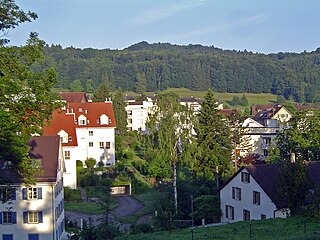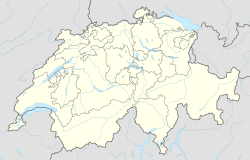
Männedorf is a municipality in the district of Meilen in the canton of Zürich in Switzerland.

Egg is a municipality in the district of Uster in the canton of Zürich in Switzerland.

Stäfa is a municipality in the district of Meilen in the canton of Zürich in Switzerland.

Uetikon am See is a municipality in the district of Meilen in the canton of Zürich in Switzerland.

Herrliberg is a municipality in the district of Meilen in the canton of Zürich in Switzerland.

Küsnacht is a municipality in the district of Meilen in the canton of Zürich, Switzerland.

Illnau-Effretikon is a municipality in the district of Pfäffikon in the canton of Zürich in Switzerland. It includes the villages of Illnau, Effretikon, Ottikon and Bisikon. On 1 January 2016 Kyburg and Illnau-Effretikon merged to form the municipality of Illnau-Effretikon.

Bauma is a municipality in the district of Pfäffikon in the canton of Zurich in Switzerland.

Oberrieden is a municipality in the district of Horgen in the canton of Zurich in Switzerland. It is one of the towns along the south shore of Lake Zurich.

Brütten is a municipality in the district of Winterthur, in the Canton of Zürich, Switzerland.

Rickenbach is a municipality in the district of Winterthur in the canton of Zürich in Switzerland.

Turbenthal is a municipality in the district of Winterthur located in the canton of Zürich in Switzerland.

Wiesendangen is a municipality in the district of Winterthur in the canton of Zürich in Switzerland. On 1 January 2014 the former municipality of Bertschikon merged into the municipality of Wiesendangen. At the same time the Community Identification Number changed from 0229 to 0298.

Birmensdorf is a municipality in the district of Dietikon in the canton of Zürich in Switzerland.

Urdorf is a municipality in the district of Dietikon in the canton of Zürich in Switzerland, located in the Limmat Valley.

Hombrechtikon is a municipality in the district of Meilen in the canton of Zürich in Switzerland.

Oetwil am See is a municipality in the district of Meilen in the canton of Zürich in Switzerland. It is located in the Pfannenstiel region.

Zollikon is a municipality in the district of Meilen in the canton of Zürich, Switzerland known for being one of Switzerland's most exclusive districts. Besides the main settlement of Zollikon, which lies on the shore of Lake Zürich, the municipality also includes Zollikerberg, at a higher elevation on the road from Zürich to Forch. It is also known as the place of residence of Bubbi.

Hittnau is a municipality in the district of Pfäffikon in the canton of Zürich in Switzerland.

Fällanden is a municipality in the district of Uster in the canton of Zürich in Switzerland, and belongs to the Glatt Valley.



























